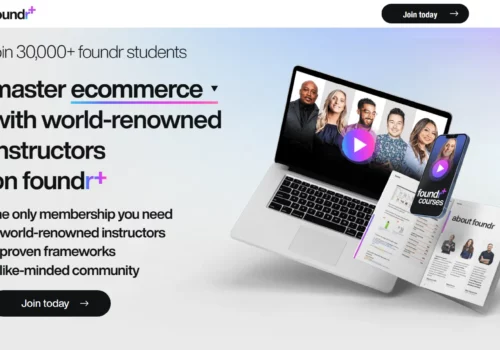Gone are the days when you can only “promise” your prospects that the investment is worthwhile, now you can prove it. There is no better way to demonstrate your experience than to create an online course.
By teaching the subject, you leave no doubt that you know what they are talking about, what you do well and you are an expert in the field.
The online course is now essential for any toolbox of entrepreneurs, experts or thought leaders such as websites and business cards.
One of the fastest and most effective ways to bring your knowledge to a global marketplace is by making it bigger and by transforming latent knowledge of your brain into a lead generator that generates money. An online course is an easy way to make an impact.
How To Create A Highly Successful Online Course 2024
This article provides a general description of the 10 main steps to create an online course:
While this is not an exhaustive list of everything that needs to be planned, prepared, and executed to create a successful online course, it provides insight into key milestones so you know what to expect and how will the journey be before the start.
1. Choose the perfect course theme
Your course theme should be something that you like. If you are not interested in your topic, it is obvious that you do not like it and that your training is as attractive as a cardboard sandwich.
Do not feel obligated to teach a profession at the college level. Think about your skills, talents and life experiences. Cook your favorite dishes, interior design, write fiction, overcome the death of a loved one … the list of possible topics of the course is endless.
In summary, if you love your topic, are gifted, and have experience (formal or lifelong), you have a theme that will work for you.
2. Make sure your idea has high market demand
After choosing the topic of your course online, the next step is to conduct a series of market research tests to determine if you have market demand or not. Many course designers make the mistake of believing that the idea of their course does not work if there is much competition in their field. In reality, however, this shows that this idea is very likely to be in high demand in the market and it is, therefore, worth continuing research.
The three most important things you want to check are:
- Do people talk about it?
- Do people ask?
If your answer to the previous three questions is “yes” and your idea is similar but different from the one you already have, then you have an idea of the course that may have commercial success.
3. Create magnetic and compelling learning outcomes
Do not underestimate the importance of learning outcomes. If you do not do this for your online courses, you run the risk of seriously jeopardizing your reputation and outcomes, not to mention the frustration of the course building process.
Would you give your money to someone for a product that they do not understand and have no idea what they will do for you? Of course not
The fact that you know what your course will give your students does not mean that they will know.
If your students do not know how their course will help them, they are unlikely to register.
The learning outcomes use measurable verbs to explain what the student can do, know and feel at the end of the class.
What skills can you demonstrate?
What new knowledge will you have acquired?
What feelings do they move from or towards?
Clear learning outcomes also ensure that only the right students attend your course. This means higher completion and satisfaction rates and fewer claims.
4. Research and collect the content of your course
In this phase, many course designers run the risk of getting into the “hole of eternal delay”.
The main reason we’re stuck here is often due to the amount of information we have in our heads or around us in books, on our hard drives, in our laptops, and so on. At this stage, art is not just about what we should include in our course, but also what we should omit.
Once again, research and learning outcomes will be useful during the test phase of the market. When you sort your piles of content, you are throwing away everything that is not directly related to achieving a learning outcome.
Second, make sure that the content of each learning outcome agrees with it.
Only add content that answers your audience’s questions or fill in gaps your competitors have not yet filled.
5. Structure your modules and your timetable
At this point, you observe all the content and begin to group your topics, suggestions, and similar ideas into modules, and then arrange the classes of these modules in the most progressive and logical way for them to form. a fluid stream. Order of lessons.
6. Determine the most attractive and effective dissemination methods for each lesson.
Now is the time to decide how to best serve your content. You need to know the different principles of adult education, learning preferences and all training methods to make your training as attractive as possible.
Do you have videos, content to read, activities and audio content?
What kind of pictures do you have?
Are you going to have community learning zones?
You need to make sure that you have a balance of visual, auditory, and practical methods so that everyone is involved and can benefit from the optimal learning experience.
7. Save and edit your course online
This is the production phase. At this point, you need a complete lesson plan, the entire content, and the exact way to teach each element of your course online.
It’s time for the fun part: go to the camera.
Of course, the way you conduct your training depends entirely on what your listeners prefer and the method that provides the most effective learning outcomes.
However, a video is currently the most effective method of distribution.
This could be a “talking head” when you are in the picture with the camera.
You can also display videos of “talking heads” on the green screen.
This means that you have a green background behind you: If you have a green screen, you can leave everything behind while editing. It can be a video behind you, animations or just a still picture. I’m using the green screen to get past my PowerPoint slides in the post-production phase. It’s perfect for my workout and class type.
Another method is called screencasting, that is when you save your computer screen: you can add a webcam video.
You can easily learn how to edit your videos: I use software called Camtasia.
This will allow you to quickly crop editing, replace the green screen, correct the sound, and add logos, text, and pop-ups to your videos. Save it in MP4 format and upload it to your e-learning system.
Related: The best equipment and software for creating online courses.
8. Get Your Course online
First, recognize that there are three ways to sell your courses online.
Online Course markets- Such as Udemy, Skillshare
Learning Management Systems– Such as Teachable and Udemy
Plugins or software on your website- Such as Learndash
There is a big difference between online price markets and learning management systems.
A learning management system is your own academy that allows you to link to your website and fully qualify on your own platform. It facilitates and simplifies the creation of online courses to sell your learning products.
9. Get the perfect pricing and feed a business model based on the best education
Make sure you have a strategy of how and where your online course fits into your overall business model.
- Will it be easy to get a free magnet in your main product and service?
- Will it be a full source of revenue?
- Will it be your main source of income?
Each of these elements means that your course has to be slightly different, offers a different value volume and different marketing methods, and places your followers and students in very different types of funnels.
This also has a significant impact on the price you need to apply to your online course in order to adapt to the job assigned to you in your company.
There is no good or bad price, not even a reference price for an online course, as it depends very much on the teaching content. However, as a starting point, I recommend that you analyze and compare your idea with competing products in the marketplace: Find out what your competitors are demanding and for what, and find out how your product can be different and better. If you have improved it, the price is a bit higher.
Never set a lower price for you as it will result in your price is worth less than your competitors’.
10. Start Marketing Your Course
If you think the job is done now, after completing your online course, think again that the real work is about to begin!
Too many course designers make the mistake of thinking that once they have their course, they now have an income. You must initiate an ongoing marketing strategy to promote your course and enroll students.
- Do you want to make discount offers at dawn?
- Do you want to publish ads? Do you have a content marketing plan that sells your courses online?
- Do you have a list on the market?
- Can you connect with influencers?
- Are you going to give a partner program?
- How will you use social networks?
The list is endless.
Make sure that you have at least 18 months of the marketing plan for your online course, and remember that the second time you stop marketing is the second time you stop selling.
Related Read:
- List of Top 25 Best WordPress Business Themes in 2021
- WP Courseware Review
- Babbel Coupon Code
- Springboard.com Coupon Code
- Edureka Coupon Code
Top 4 Platforms To Create A Highly Successful Online Course 2024
1. Teachable
With Teachable you can:
Create engaging multimedia conferences
Add video, image, text, audio, and PDF files. Simply upload content directly from Dropbox, Google Drive or OneDrive.
Build a nice website
Its intuitive drag-and-drop generator lets you work with your existing website or create new pages in Teachable.
Enchant the students on every device
Your course website is fully responsive so students can view your content from computers, tablets, and smartphones.
Change any aspect of your school.
With the Power Editor, you or your team can deepen the code and make advanced adjustments.
published sales pages.
With a powerful page editor, you can easily create, customize and launch new course pages.
It reaches students from all over the world in all languages.
You can change the language used in any part of your website to support the international audience.
Create Quizzes
Just create a quiz with the native function to reinforce learning, summarize important information, and review your students’ progress.
Discussion forums
Activate conversations and answer your conference questions with our native comment feature. Moderate the comments before they are published publicly.
Certificate of completion.
Issue completion certificates to reward your students and verify their success. Customize your individual certificate for each course.
2. Thinkific
With Thinkific you can:
Customize the way your course system runs with the click of a button
- Private and hidden courses
- Prerequisite lessons
- Multiple instructors
- Drip schedule content
- Cohorts
- Evergreen and expiring content
- Membership sites
Reach more students with Its advanced marketing tools
-
Reward affiliates for sharing your courses
Incentivize your partners with customized commission rates and direct tracking.
-
Easily connect your favorite email provider
Create highly targeted campaigns that send emails to the right people at the right time.
-
Improve campaigns with advanced data tracking
Comprehensive support for analytics and ad tracking including Google Adwords, Facebook, and retargeting campaigns.
-
Integrate with over 1000 external business and marketing apps
Thinkific effortlessly integrates with your favorite business tools.
Download content quickly and drag and drop it to create the perfect program
Thinkific is easy enough to start a course fast, but strong enough for the most demanding online schools without coding.
Show off your lessons with topics designed specifically for selling education
Thinkific customers sold over $ 200 million worth of stock. You can sell with confidence on a website, including a pre-built instructor, curriculum, key findings, and course assessment sections. You can start by selecting one of our carefully designed themes and customize each article of your brand.
Personalize the website of your course with maximum performance.
You can organize content with the drag-and-drop creator and easily add, delete or reorder sections of your class.
Use your own domain name
You can create a brand new course site with Thinkific or build tight links to your existing website to provide a seamless experience for students, regardless of the type of domain or website.
In addition, you can go with full access to HTML and CSS
Their system is designed to be easy for anyone to use. However, if you are a website developer, you have full access under the hood.
Related Read:
3. Udemy
One of the exceptional things about creating an online course on Udemy is that your students can access your courses from several different devices and platforms, including a desktop/laptop, Android app, iOS app, and Apple TV app.
Some of the Udemy features are:
- Course Marketing
- Retargeting Ads
- Ad Hoc Email Campaigns
- Action-Based Email Campaigns
- Search and Discovery
- External Partnership Promotions
- Earn Extra Income
- Course Quality Checklist
- Assignments
- Coupons and Discounts
- Training Videos
- Course Catalog
- Teach Hub
4. LearnDash
With LearnDash you can have:
Intelligent Course Builder
LearnDash’s drag & drop Course Builder allows you to easily create (and re-use) multi-layer courses. Create course categories, lessons, topics, assignments, and quizzes. You can rename the labels to anything you wish. For example, you can rename “Lessons” to “Modules”.
Advanced Quizzing
Using LearnDash you can choose from eight different question types with the options you need to customize the quizzing experience.
Drip-Feed Content
You can deliver all your lessons all at once, or choose to drip-feed (schedule) them over a specified amount of time resulting in a guided learning experience. You have two primary options for scheduling your lessons:
-
Lesson Timers
Don’t want your learners skipping ahead? You can prevent them from moving through your courses too quickly by simply setting a Lesson Timer. When the clock reaches “zero”, learners are then permitted to move onto the next Lesson.
-
Flexible Prerequisites
Using LearnDash prerequisites you can determine which courses need to be taken and in what order. Create a guided learning path or give learners the option to choose the courses they take.
Dynamic Forums
You can encourage course conversation among learners by adding a course specific forum to your courses and limit participation to only those who are enrolled in the course
Gradebook
You can take your class LMS to another level by using the feature-packed LearnDash Gradebook.
Course Points
You can offer award points to learners as they complete courses, and allow learners to unlock new courses based on the points they have earned – great for letting them choose their own dynamic learning path!
Certificates & Badges
You can offer awards and custom certificates and points for course activities.
User Profiles
LearnDash offers robust user profiles so your learners can see which courses they can access, their progress, quiz performance, and print any earned certificates. As the admin, you can quickly and easily manage your users.
Email Notifications
Communicating with learners and Group leaders is too easy with LearnDash email notifications.
Group Management
LearnDash Groups is a great way to mass-enroll users into courses and to make sure that they are all on the same drip-feed schedule for the content. You can also pull group related reports so you always know how they are performing.
Detailed Reporting
LearnDash reporting captures all the details you care about on your learners and courses.
Assignment Management
Assignments can be required at the Lesson level and the Topic level. you can choose to have them automatically approved, or require that they be manually awarded points & approved.
Quick Links:
-
Teachable Vs Udemy: Which Is Great For Creating Online Courses?
-
Thinkific vs Teachable 2024: Which is Perfect For Online Course Creation?
-
How To Build An Online Course In 15 Minutes With Everlesson 2024
-
The Definitive Guide To Build An Online Courses Using WordPress Plugins 2024
Conclusion: How To Create A Highly Successful Online Course 2024
Hopefully, you got a fair idea of what it takes to create a successful online course. Let me know in the comments section below what you think of it and your personal experience while creating an online course.











